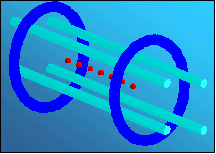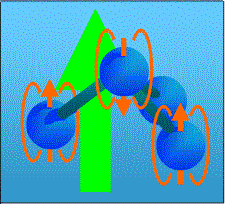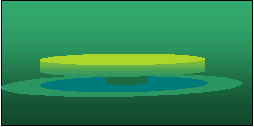Qubit Systems
Contents
- Introduction
- Simulator
- Qubit Systems
- More Information
15709 visits
The following describes some systems currently being developed for use as qubits, the quantum version of bits.
Ion traps
 An ion is an atom with extra or missing electron. Being electrically charged, individual ions can be trapped
using electric and magnetic fields. The linear ion trap pictured uses 4 rod electrodes (light blue) which are fed an AC
voltage of about 1 kilovolt at a frequency of a few megahertz. This confines the ions (red dots) along a central line. The
end-rings (dark blue) are electrically charged to prevent the ions from escaping at the ends.
An ion is an atom with extra or missing electron. Being electrically charged, individual ions can be trapped
using electric and magnetic fields. The linear ion trap pictured uses 4 rod electrodes (light blue) which are fed an AC
voltage of about 1 kilovolt at a frequency of a few megahertz. This confines the ions (red dots) along a central line. The
end-rings (dark blue) are electrically charged to prevent the ions from escaping at the ends.
Finely focused lasers are used to prepare and inspect individual ions. The outer electron of each ion is manipulated to be in two different orbits about the nucleus. Each ion therefore represents a qubit. As an ion scatters photons from the laser it recoils. Its recoil motion is felt by the other ions. This recoil motion is equivalent to the data bus of a classical computer
Dr Dave Kielpinski uses ion trap technology in his Trapping and Cooling Laboratory within the Centre for Quantum Dynamics
Nuclear magnetic resonance (NMR)
 The nucleus (blue
ball) of an atom can have a magnetic moment (orange arrow), i.e. the nucleus behaves as a tiny permanent magnet. The
nucleus displays an unusual behaviour when placed in a strong magnetic field (green arrow). Owing to its quantum
nature, the nuclear magnetic moment is aligned either in the same direction as or the opposite
direction to the surrounding magnetic field. The orientation of the nucleus is therefore confined to two distinct
values and so it represents a qubit. Adjacent nuclei also affect each other through their magnetic moments in the
same way as two magnets placed near each other. This interaction allows one nuclear qubit to control an adjacent
nuclear qubit. Quantum computation is carried out using radiofrequency fields to flip the nuclear moments. Output data
is obtained by measuring the radiofrequency fields generated by oscillating moments.
The nucleus (blue
ball) of an atom can have a magnetic moment (orange arrow), i.e. the nucleus behaves as a tiny permanent magnet. The
nucleus displays an unusual behaviour when placed in a strong magnetic field (green arrow). Owing to its quantum
nature, the nuclear magnetic moment is aligned either in the same direction as or the opposite
direction to the surrounding magnetic field. The orientation of the nucleus is therefore confined to two distinct
values and so it represents a qubit. Adjacent nuclei also affect each other through their magnetic moments in the
same way as two magnets placed near each other. This interaction allows one nuclear qubit to control an adjacent
nuclear qubit. Quantum computation is carried out using radiofrequency fields to flip the nuclear moments. Output data
is obtained by measuring the radiofrequency fields generated by oscillating moments.
The largest quantum computer built to date is a 7 qubit device based on nuclear magnetic resonance. Unfortunately, technological difficulties limit the size of these devices to about 10 qubits. Nevertheless, nuclear magnetic resonance has been useful for demonstrating the principle operation of a quantum computer.
Quantum dots
 Using advanced lithographic techniques it is possible to etch small structures called quantum dots in
semiconductor materials. Each such dot, which can be as small as 30nm across (about 30 times the size of an atom) can
confine a single electron in discrete energy levels.
Using advanced lithographic techniques it is possible to etch small structures called quantum dots in
semiconductor materials. Each such dot, which can be as small as 30nm across (about 30 times the size of an atom) can
confine a single electron in discrete energy levels.
Thus the quantum dot behaves like a large artificial atom and can be used as a qubit. A user can access individual quantum dots using focused laser beams which can flip the electron between two discrete energy levels or place it into a superposition of the two levels. The required interaction between qubits occurs through externally applied electric and optical fields.
Other qubit systems
It seems that almost every system which exhibits quantum phenomena has been identified as a candidate for quantum computing. These include (but are not limited to) the following.
Cavity QED. In cavity Quantum ElectroDynamics, atoms interact strongly with photons trapped between extremely reflective mirrors. It is possible to entangle the atom with the light field to make quantum logic gates.
Nonlinear optics. Photons do not interact with each under normal circumstances. But if two light beams cross in a nonlinear material, the photons in one beam can affect photons in the other. One such material currently being explored is a cloud of cold atoms which is made transparent using other fields.
Linear optics. Linear optical elements (mirrors, beamsplitters) and single photon sources, can be used to perform quantum algorithms. Entangled states can be created by selective measurements. One drawback is that the system functions 'correctly' only some of the time, so the computation has to be repeated many times to get the desired answer.
Assoc Prof Geoff Pryde exploits the quantum properties of light in his Quantum Optics Laboratory which is also part of the Centre for Quantum Dynamics
SQUIDs. These are Superconducting QUantum Interference Devices. Small gaps are made in a superconducting loop of metal creating an 'island'. The qubit is the electric charge on the island. The rate electrons tunnel across the gaps is controlled by external electric and magnetic fields.